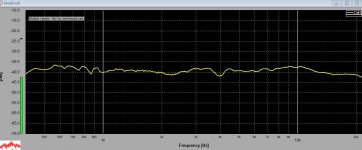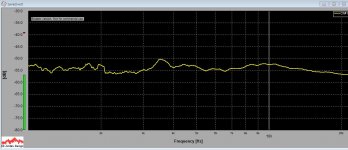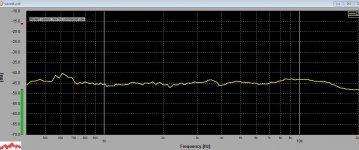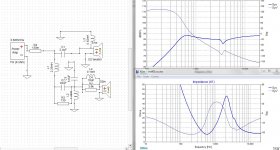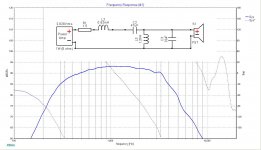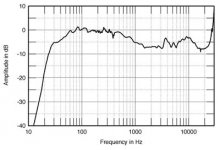Well, here it is. The filter is now installed at crossover output in the plinth.
(I've only done one channel at this stage)
The bump has now gone but there's now a new suck-out at 4kHz, so there's some fine tuning still needed. On a positive note, the flattest response is now bang on axis and at a very slightly lower angle than before, which is perfect because it's now exactly in line with my ears when seated on the couch.
(I've only done one channel at this stage)
The bump has now gone but there's now a new suck-out at 4kHz, so there's some fine tuning still needed. On a positive note, the flattest response is now bang on axis and at a very slightly lower angle than before, which is perfect because it's now exactly in line with my ears when seated on the couch.
Attachments
Actually, the suck-out isn't as serious as I first thought.
At double the measurement distance it's barely noticeable, so I'll mod the other speaker and see if the measurements are similar.
That plot if on axis data is superior to other on axis plots you posted, thanks sharing.
The bump has now gone but there's now a new suck-out at 4kHz, so there's some fine tuning still needed. On a positive note, the flattest response is now bang on axis and at a very slightly lower angle than before, which is perfect because it's now exactly in line with my ears when seated on the couch.
This is actually one of the main reasons I disliked the parallel connected notch that is placed in series with the rest of the passive crossover. As you can see in the graph I posted above, the transfer function of the low pass has a high Q target and results in a hump around 4-5kHz. Adding in the series notch filter affected this hump and it seems like something similar has possibly happened to you, reducing the output around 4-5kHz and producing a small dip in the frequency response.
Remember that 800 is the pinnacle i.e. state of art of a company with a great reputation on the audio market.
And here in lies the problem, there is nothing to remember, the 800 is NOT the pinnacle, it is not a state of the art design, far from it and it's flawed in a number of significant ways. There are things that need correcting and there are things that need redesigning. This is why I said before that I would love to get my hands on an 800/801/802 and redesign the crossover. Ideally B&W would mould a waveguide into the marlan head pod for the midrange/tweeter and add in some directivity control for the diamond tweeter, I cannot see them doing this but it would be a nice step in the right direction towards improving the off axis performance of the series.
And here in lies the problem, there is nothing to remember, the 800 is NOT the pinnacle, it is not a state of the art design, far from it and it's flawed in a number of significant ways. There are things that need correcting and there are things that need redesigning. This is why I said before that I would love to get my hands on an 800/801/802 and redesign the crossover. Ideally B&W would mould a waveguide into the marlan head pod for the midrange/tweeter and add in some directivity control for the diamond tweeter, I cannot see them doing this but it would be a nice step in the right direction towards improving the off axis performance of the series.
oh geezzz!!! Why don't you contact B&W and see if the hire you?
Please share your designs let us see what you brought to the commercial world that has received so many prices then I will be quiet and not question your absurd observation of talking down a $24K speaker as if it was a best buy $500 WITHOUT HAVING EVEN LISTENED TO IT!!! 😱
If you show me facts that you are a state of art designer I will send you my B&W at my expense for a makeover!
And now the other (right channel) modded
Very similar, thankfully. Now it's time for a listen. 🙂
I am very curious to know what you think about it compared to the original XO.
Thanks for carrying this on, you are the master! 😎
oh geezzz!!!
If you show me facts that you are a state of art designer
I will send you my B&W at my expense for a makeover!
I reckon it would be cheaper to invite 5th to your home to make
the modification in situ. After all, you will avoid the risk of getting
the cabinets damaged, not to mention other repercussions.

I reckon it would be cheaper to invite 5th to your home to make
the modification in situ. After all, you will avoid the risk of getting
the cabinets damaged, not to mention other repercussions.
AHAHAHAHAHA!!! That's true actually!!!

This is actually one of the main reasons I disliked the parallel connected notch that is placed in series with the rest of the passive crossover. As you can see in the graph I posted above, the transfer function of the low pass has a high Q target and results in a hump around 4-5kHz. Adding in the series notch filter affected this hump and it seems like something similar has possibly happened to you, reducing the output around 4-5kHz and producing a small dip in the frequency response.
Yeah, the 100% solution is a combined parallel RLC in series with series RLC in shunt, which nicely cancels the asymmetries. When I simulated the networks within the full M-T crossover the parallel RLC network looked the best but I needed to fine tune the mid HPF crossover element cap value (10 > 13.3uF) to remove a peak at 2.8kHz, at the expense of creating a minor dip at 4kHz, and that's exactly what's happened. When time permits I'll play with the notch values to optimise as best I can but it's clearly better than it was before and after a lengthy listening session last night I'm very convinced that the on-axis performance is not only better than before but it's also as close to (subjectively) perfect as I've ever heard from my system. Interestingly, the slight undulations in the mid treble (4 - 7kHz) seem to have disappeared, which is an unexpected bonus. I previously never listened on-axis because the mid > treble transition didn't seem completely correct and overall the balance was a bit hot on top, whereas it's now perfect in every way.
I should add that I've also connected a 5W 68R in shunt with the 44uF Mundorf SIO to reduce the 600Hz bump by 1dB, and I've removed the additional resistors that were in series with the MT input as a temporary fix.
When I'm happy with the values I'll order the Mundorf caps and coils and will install them off the PCB in some free space. (and I'll provide some pics of course)
Btw, the overall quality of the crossover assembly is really outstanding, and fortunately is also easily accessed, unlike many speakers that require you to remove bass drivers etc.
My only other comment is that the speakers weigh 100+kg, which definitely sorts the men from the boys.
Good work its interesting and educating thanks sharing.
If you need a 4 ohm driver in XSim attach a txt file where you just have to rename the extension to dot zma and it can be linked to the standard linear 8 ohm driver. Made it with my DATS device sweeping a 4 ohm resistor and exported as zma file. Should also be possible to manipulate the standard 8 ohm driver higher or lower in impedance by adding serial or parallel resistors to its terminals.
EDIT By import a zma file from particular left and right driver impedance sweep may give highest precision for the network values i think, and this could be even better if include sweept DCR value for every component.
If you need a 4 ohm driver in XSim attach a txt file where you just have to rename the extension to dot zma and it can be linked to the standard linear 8 ohm driver. Made it with my DATS device sweeping a 4 ohm resistor and exported as zma file. Should also be possible to manipulate the standard 8 ohm driver higher or lower in impedance by adding serial or parallel resistors to its terminals.
EDIT By import a zma file from particular left and right driver impedance sweep may give highest precision for the network values i think, and this could be even better if include sweept DCR value for every component.
Attachments
Last edited:
The B&W drive unit in question has a DCR of 3.2 ohms and an Le of 0.18mH which can be used for effective simulation of the low pass function of the FST.
I have attached a ZMA file that one can use to simulate the transfer function for the FST too if they so desire. Attached as a zip to simplify file extension rubbish. If you wish to simulate the high pass behaviour of the driver then you need its resonant behaviour included and if you want to simulate the low pass correctly then you need its inductive rise included.
It's nice that you're having positive results with your crossover modding Art.
Stefanoo my opinions are purely objective and based solely on scientific fact. Scientific fact based off of the accurate and almost extensive set of measurements provided by Stereophile and scientific fact based on the large body of research carried out by objectively focused individuals interested in finding out what kind of metrics one should use to judge, or arrive at pleasing and accurate sound reproduction via loudspeakers.
You on the other hand are clearly getting emotional about something that, given your engineering background, you should be able to remain purely objective about. University credentials, accolades and ones body of commercial work are completely irrelevant towards the learnt ability required to accurately assess the technical capabilities of a loudspeaker based on those metrics and with the measurements provided.
If you do not like it that these facts say that your $24000 speakers are inherently flawed then you need to get over it. Price and pedigree do not a good pair of loudspeakers make.
I have attached a ZMA file that one can use to simulate the transfer function for the FST too if they so desire. Attached as a zip to simplify file extension rubbish. If you wish to simulate the high pass behaviour of the driver then you need its resonant behaviour included and if you want to simulate the low pass correctly then you need its inductive rise included.
It's nice that you're having positive results with your crossover modding Art.
oh geezzz!!! Why don't you contact B&W and see if the hire you?
Please share your designs let us see what you brought to the commercial world that has received so many prices then I will be quiet and not question your absurd observation of talking down a $24K speaker as if it was a best buy $500 WITHOUT HAVING EVEN LISTENED TO IT!!!
If you show me facts that you are a state of art designer I will send you my B&W at my expense for a makeover!
Stefanoo my opinions are purely objective and based solely on scientific fact. Scientific fact based off of the accurate and almost extensive set of measurements provided by Stereophile and scientific fact based on the large body of research carried out by objectively focused individuals interested in finding out what kind of metrics one should use to judge, or arrive at pleasing and accurate sound reproduction via loudspeakers.
You on the other hand are clearly getting emotional about something that, given your engineering background, you should be able to remain purely objective about. University credentials, accolades and ones body of commercial work are completely irrelevant towards the learnt ability required to accurately assess the technical capabilities of a loudspeaker based on those metrics and with the measurements provided.
If you do not like it that these facts say that your $24000 speakers are inherently flawed then you need to get over it. Price and pedigree do not a good pair of loudspeakers make.
Attachments
The B&W drive unit in question has a DCR of 3.2 ohms and an Le of 0.18mH which can be used for effective simulation of the low pass function of the FST.
I have attached a ZMA file that one can use to simulate the transfer function for the FST too if they so desire. Attached as a zip to simplify file extension rubbish. If you wish to simulate the high pass behaviour of the driver then you need its resonant behaviour included and if you want to simulate the low pass correctly then you need its inductive rise included.
It's nice that you're having positive results with your crossover modding Art.
Stefanoo my opinions are purely objective and based solely on scientific fact. Scientific fact based off of the accurate and almost extensive set of measurements provided by Stereophile and scientific fact based on the large body of research carried out by objectively focused individuals interested in finding out what kind of metrics one should use to judge, or arrive at pleasing and accurate sound reproduction via loudspeakers.
You on the other hand are clearly getting emotional about something that, given your engineering background, you should be able to remain purely objective about. University credentials, accolades and ones body of commercial work are completely irrelevant towards the learnt ability required to accurately assess the technical capabilities of a loudspeaker based on those metrics and with the measurements provided.
If you do not like it that these facts say that your $24000 speakers are inherently flawed then you need to get over it. Price and pedigree do not a good pair of loudspeakers make.
why u must bother him? he's just a clown who think hes speaker so damn good cause so damn expensive . But thx to him , I can read and learn from yours post and art post.
Yeah, the 100% solution is a combined parallel RLC in series with series RLC in shunt, which nicely cancels the asymmetries. When I simulated the networks within the full M-T crossover the parallel RLC network looked the best but I needed to fine tune the mid HPF crossover element cap value (10 > 13.3uF) to remove a peak at 2.8kHz, at the expense of creating a minor dip at 4kHz, and that's exactly what's happened. When time permits I'll play with the notch values to optimise as best I can but it's clearly better than it was before and after a lengthy listening session last night I'm very convinced that the on-axis performance is not only better than before but it's also as close to (subjectively) perfect as I've ever heard from my system. Interestingly, the slight undulations in the mid treble (4 - 7kHz) seem to have disappeared, which is an unexpected bonus. I previously never listened on-axis because the mid > treble transition didn't seem completely correct and overall the balance was a bit hot on top, whereas it's now perfect in every way.
I should add that I've also connected a 5W 68R in shunt with the 44uF Mundorf SIO to reduce the 600Hz bump by 1dB, and I've removed the additional resistors that were in series with the MT input as a temporary fix.
When I'm happy with the values I'll order the Mundorf caps and coils and will install them off the PCB in some free space. (and I'll provide some pics of course)
Btw, the overall quality of the crossover assembly is really outstanding, and fortunately is also easily accessed, unlike many speakers that require you to remove bass drivers etc.
My only other comment is that the speakers weigh 100+kg, which definitely sorts the men from the boys.
This is really interesting to me and I have to say that I am really surprised with your results. Initially you seemed to not been able to tell any difference between the two XOs and that actually you felt the original was slightly better. Thanks anyway for sharing this information with us.
If you provide me with the schematic and parts you want to use, I can design a PCB that will fit as a drop replacement for your midrange XO (and mine too).
All I need...so that I don't have to disassemble mine at the moment, I will eventually do that later....is the dimension of the board and mounting holes of existing XO.
Now I am wondering, will the same network work for my speaker as well? If I am not wrong, we had same XO type of filter for the midrange, but on yours, the cut off frequency have been moved out due to the different tweeter and also the tweeter had of course a different XO.
Again, I don't see any reasons as to why B&W shouldn't have done the same thing, which actually took you not even a couple of days. I am assuming B&W spent hours and hours in designing this network.
Can anybody here give me a reasonable opinion as to why they did this?
Are you also going to suggest your friend with the Signature to do the same thing? If so, I would be interested, because a signature with the different tweeter might need a different XO, not sure.
Let me know your thoughts.
The B&W drive unit in question has a DCR of 3.2 ohms and an Le of 0.18mH which can be used for effective simulation of the low pass function of the FST.
I have attached a ZMA file that one can use to simulate the transfer function for the FST too if they so desire. Attached as a zip to simplify file extension rubbish. If you wish to simulate the high pass behaviour of the driver then you need its resonant behaviour included and if you want to simulate the low pass correctly then you need its inductive rise included.
It's nice that you're having positive results with your crossover modding Art.
Stefanoo my opinions are purely objective and based solely on scientific fact. Scientific fact based off of the accurate and almost extensive set of measurements provided by Stereophile and scientific fact based on the large body of research carried out by objectively focused individuals interested in finding out what kind of metrics one should use to judge, or arrive at pleasing and accurate sound reproduction via loudspeakers.
You on the other hand are clearly getting emotional about something that, given your engineering background, you should be able to remain purely objective about. University credentials, accolades and ones body of commercial work are completely irrelevant towards the learnt ability required to accurately assess the technical capabilities of a loudspeaker based on those metrics and with the measurements provided.
If you do not like it that these facts say that your $24000 speakers are inherently flawed then you need to get over it. Price and pedigree do not a good pair of loudspeakers make.
5th I understand what you say, but again, saying that this is a flawed design is a big word considering the quality of sound these monitors can produce.
I am not saying at this point that you are necessarily wrong, but I am going back to the same point: if you look purely at frequency response, you can find a 500 dollar unit that will have a flat frequency response. Would you now say that this will perform better than my sig800?
If you say so, I would question your listening abilities. If you agree with me that it won't perform as good, then you also have to agree with me that the "secret" of making an excellent sounding speaker doesn't only lay on a completely flat frequency response.
I am very interested in Art results, hopefully he is not getting emotional and excited by the fact that he is modifying something and automatically starts liking it (many people get on the same pitfall including me sometimes).
I am just saying that b&w spent countless hours tweaking the speaker and and the crossover, I am not so keen to think that now with a couple of simulations and few hours of work we have discovered the warm water under the bridge, just saying that it is worth to consider all aspects before making statements that are regretted later i.e. technical considerations as well as listening considerations.
Like I also said, I am NOT emotional at all about my speakers...if they can be improved I would go for it...I don't care at all!!! So I am looking at this with big interest and if the development seems promising I will also accept your reasoning and move on without strings attached! I hope you now understand that I don't have any fetish attachment to my speakers...I ONLY care about good sound and yes good technical performance and if the two get perfectly along so be it!
Trouble in the paradise
Starting from the Zaph's measurement of FST and with the
5th's zma file, I have come up with an approximation of what
is wrong with B&W's original filter. Namely, as Stereophile's
measurement of anechoic response averaged across 30 degrees
horizontal window with the complex sum of the nearfield response
plotted below 400 Hz in the 3rd photo shows, there is a response
depression caused by the values of original midrange LP filter.
With a little bit of playing around with the values, one ought to
expect something like the modded plot shows.
Starting from the Zaph's measurement of FST and with the
5th's zma file, I have come up with an approximation of what
is wrong with B&W's original filter. Namely, as Stereophile's
measurement of anechoic response averaged across 30 degrees
horizontal window with the complex sum of the nearfield response
plotted below 400 Hz in the 3rd photo shows, there is a response
depression caused by the values of original midrange LP filter.
With a little bit of playing around with the values, one ought to
expect something like the modded plot shows.
Attachments
Last edited:
- Home
- Loudspeakers
- Multi-Way
- B&W Signature 800 upgrade diamond tweeter
